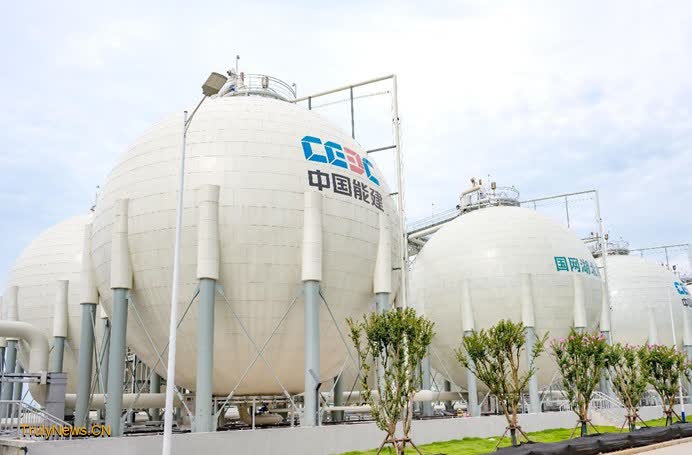At a 300 MW compressed air energy storage station in Yingcheng, central China’s Hubei province, eight heat storage and exchange tanks are erected. Five hundred meters underground, abandoned salt caverns with over 1 million cubic meters of air storage space are undergoing gas injection and brine discharge testing. The project is expected to start full-capacity operation within this year.
“This is the world’s first 300 MW compressed air energy storage station, similar to a ‘super power bank,'” said Li Jun, deputy general manager of China Energy Digital Technology Group Co., Ltd.
“It can store energy for 8 hours and release it for 5 hours daily, with an annual power generation of about 500 million kilowatt-hour,” Li added.

Photo shows heat storage and exchange tanks of a 300 MW compressed air energy storage station in Yingcheng, central China’s Hubei province. (Photo/Zhao Xueming)
Though China’s installed capacity of new energy sources like wind and solar power continues to increase, they are relatively “unpredictable,” and power supply can sometimes be excessive and at other times insufficient, with fluctuating frequencies. Energy storage is needed to act as a “green electricity manager” to balance the power grid’s supply and demand, Li explained.
How does invisible and intangible air transform into a “super power bank?”
During off-peak electricity hours, surplus power drives compressors to compress air into a high-pressure state. The compressor, similar to a bicycle pump, can push air into a “tire” – in this case, sealed air storage reservoirs like salt caverns or artificial chambers. The heat generated during air compression is stored in heat storage tanks on the ground in forms such as hot water or fused salt.
During peak electricity hours, the underground air storage releases the stored high-pressure air, while the heat storage tanks release the stored heat. At this point, the high-pressure air is heated, which gives it tremendous expansive force to drive air turbine generators. This process is similar to wind turning the blades of large wind turbines, generating electricity to supply the power grid.
Compressed air energy storage has features such as high power, long lifespan, deep peak regulation, and flexible site selection. A single unit can achieve storage capacities of hundreds of megawatts or even gigawatts, with a typical lifespan of over 30 years.
Currently, the construction period for such a power station is usually 18 to 24 months, with a unit construction cost of 6,000 yuan ($827.54) to 8,000 yuan per kilowatt. As economies of scale become apparent and engineering technology matures, construction costs are expected to further decrease.

A staff member adjusts the valves of the closed-loop cooling water system for the compressor at a compressed air energy storage station. (Photo/Ding Xiaowei)
In recent years, China’s compressed air energy storage technology has developed rapidly, with research achievements and engineering applications leading the world. From 500-kilowatt experimental installations to 10 MW demonstration projects, 60 MW commercial operations, grid connection of 300 MW units, and the completion of feasibility studies for the first 600 MW project, compressed air energy storage technology is gradually entering large-scale engineering applications. Meanwhile, system efficiency continues to improve, with many power stations reaching 65 percent to 70 percent.
Zhang Jian, vice president of China Electric Power Planning and Engineering Institute, said that from an industry chain perspective, compressed air energy storage mainly includes key components and equipment such as compressors, heat storage and exchange equipment, air storage facilities, and expanders. This is similar to thermal power and power equipment industries, with a high degree of independent control.
Currently, compressed air energy storage still has shortcomings such as relatively low energy storage per unit volume or mass, room for efficiency improvement, and relatively complex systems.
Zhang suggested that to promote large-scale industrial application of the technology, efforts are needed in technological innovation and efficiency improvement, reducing construction and maintenance costs, expanding application scenarios, policy support, and talent cultivation.
This year, China’s National Energy Administration officially released a list of 56 new energy storage pilot demonstration projects, 11 of which are compressed air energy storage projects.
“As the technology continues to improve and more projects are implemented, China’s compressed air energy storage industry is expected to embrace broader development prospects, providing strong support for building a clean, low-carbon, safe, and efficient energy system,” said Wan Mingzhong, chief expert of China Energy Engineering Corporation and chairman of China Energy Digital Technology Group Co., Ltd.